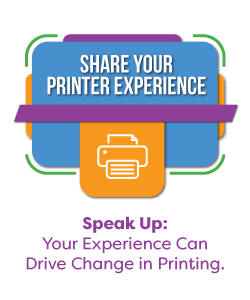Hard To Believe Workplace Stress Statistics (US & Global)
Posted by Rob Errera on 04/18/2022

Get it done! Hurry up! Do more, more more!
Workplace stress is real, even if you work from home. The additional stress of the COVID-19 pandemic over the past year has only made matters worse.
What is workplace stress?
Job stress is when your job responsibilities and relationships at work start to feel overwhelming.
This is a significant and all-encompassing problem for many people in today's world. Workplace stress can have an negative effect on your physical, mental or emotional health depending how you deal with it.

Too much work and not enough time? Welcome to Workplace Stress 101!
Workplace Stress Statistics (US): Living — And Working — With Stress
Take a deep breath. Count to five. Let it out.
Stress affects us all, but some people are better at managing stress than others.
Anxiety emerges when you feel helpless, out of control, or overwhelmed. Job demands can increase these stress factors, regardless of profession.
No matter what you do or who you are, chances are you experience some level of work stress. Stressed-out employees are neither happy nor productive.
American workplaces are experiencing a legitimate mental health crisis!
These workplace stress statistics numbers don’t lie.
Let’s look at how stress affects American workers:
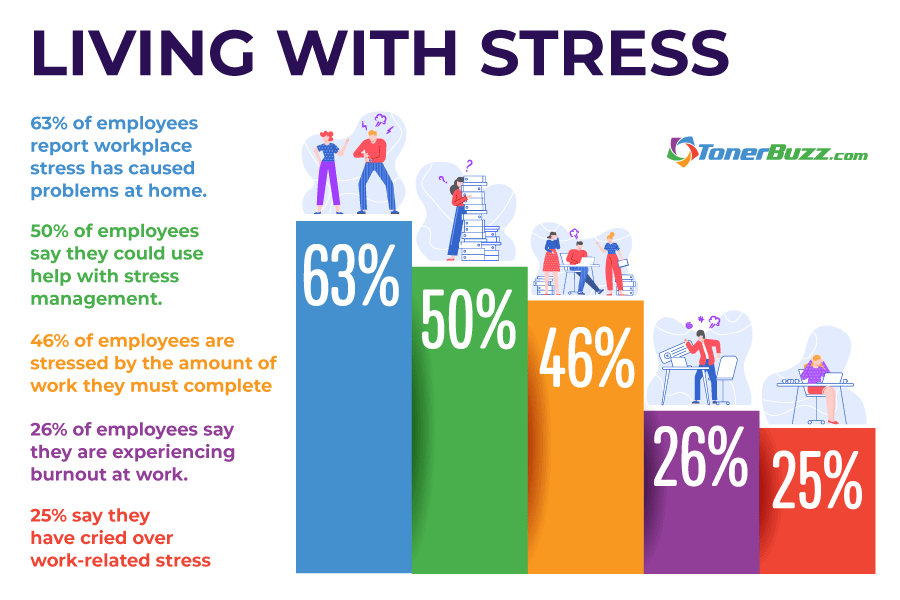
- 80% of employees say they experience some level of workplace stress.
- 26% of employees say stress causes they are experiencing burnout at work.
- 50% of employees say they could use help with stress management.
- 25% of stressed-out respondents say they feel like screaming or hitting something.
- 25% say they have cried over workplace stressors.
- 63% of employees report that work-related stress has caused problems at home.
- 10% of employees say stress causes major personal issues.
- 10% of employees are worried a colleague might become violent.
- 2% of workers have hit a co-worker.
- 18% of employees say they experienced verbal abuse at work last year.
- 42% say screaming and yelling are commonplace at work.
- 85% of employees have some level of conflict at work.
- 53% of Americans feel stress in the workplace during the day.
- 63% of employees are ready to quit their jobs due to stress at work.
- 44% of American employees say workplace cleanliness post-pandemic is one of the causes of stress at work.
- Over half of employees reported stress negatively impacts their job performance.
The High Cost Of Stress At Work
Besides the toll that workplace stress takes on the physical and mental health of employees, it also carries a high price tag in terms of lost productivity.
- US businesses lose up to $300 billion annually because of workplace stress and productivity loss
- 120,000 deaths are blamed on work-related stress each year, at the cost of $190 billion
- One million workers miss work every day due to stress
- Companies spend millions to determine stress levels and cover productivity costs lost due to absenteeism
- Managers spend approximately six hours per week — roughly 15% of their time — solving work and stress conflicts
- According to the UK Mental Health Foundation, workers who are stressed out lose an average of 24 days of work each year due to poor health
- 8% of total national healthcare spending goes toward treating workplace stress and employees experiencing mental health issues
- 43% of the American population experience stress to the point where it affects physical and mental well-being, as well as family life
Workplace stress statistics show just how many problems work-related stress can cause. Stress leads to great human and financial costs.
Both private companies and public institutions are attempting to improve management-worker relations to create less stressful working environments.
Increased financial concerns and a grim future ahead have stirred businesses to hold stress management classes targeting organizational behavior and identifying stress causes.

Want to reduce workplace stress? Listen to what your employees are saying!
Worried Sick At Work
Stress and work affect your body inside and out … and not in a good way. Work-related stress can affect promotion opportunities and prevent you from properly resolving personal problems.
Stress research reveals how severe the schism between productivity costs and poor health has become.
The American Psychological Association conducted a study about the effects of stress at work and stress-related issues in the workplace. Many employees had health concerns.
Stress causes 120,000 deaths each year, according to the American Institute of Stress. In addition to causing 120,000 deaths annually, stress impacts health by prompting other mental health problems that affect around 1 million workers.
Causes Of Workplace Stress
Common stress factors at work include:
- Ineffective company communication between employers and employees
- Unrealistic job expectations
- Concerns over occupational safety
- Negative office politics can trigger stress
- Increased financial concerns
- 60% blame their boss for stress at work
- Nearly half of employees report feeling stressed at work by the number of tasks they must complete
Workers cope with stress differently. It’s important to recognize the warning signs of worker burnout.
Some overly stressed employees will frequently skip lunch while others may turn to illicit drugs. Prevent further absences by understanding how anxiety affects your staff and recognizing warning signs of workplace stress.
What Working In A High-Stress Job Does To Your Body And Mind
Workplace statistics show that stress has harmful mental effects on workers.
Operating in a stressful working environment can:
- Reduce worker productivity
- Increase personal problems
- Cause high blood pressure
- Cause physical health problems (neck and back pain are common worker ailments)
- Lead to mental health issues
The UKG reports that fatigue and burnout statistics are the same for both on-site employees and remote workers — around 43%. Over a quarter of employees reported their workplace stress impacts mental health and can lead to depression.
How Businesses Are Combating Stress at Work
According to The Workforce Institute at UKG, nearly 60% of businesses have taken measures to combat sources of stress, while a third of employees wish their employers would still do more.
A whopping one million workers in America miss work every day, with absenteeism tied to job stress in most cases.
Many employees don’t feel safe reporting stress.
Only 40% of employees feel comfortable reporting work-related stress to their supervisors. As a result, business leaders have vowed to be more diligent about keeping those lines of employee communication open.
Good employers acknowledge the effects of stress in the workplace and understand the importance of stress management and its positive impact on mental health. Many employers are trying to help reduce excessive workplace stress by covering the healthcare costs associated with stress-related problems.
How Men And Women Handle Stress Differently
According to the APA, stress is handled differently by men and women.
- 68% of women surveyed believe stress management is an important part of self-care, compared to only 52 percent of men
- 25% of women surveyed felt they needed to do more to manage stress at work
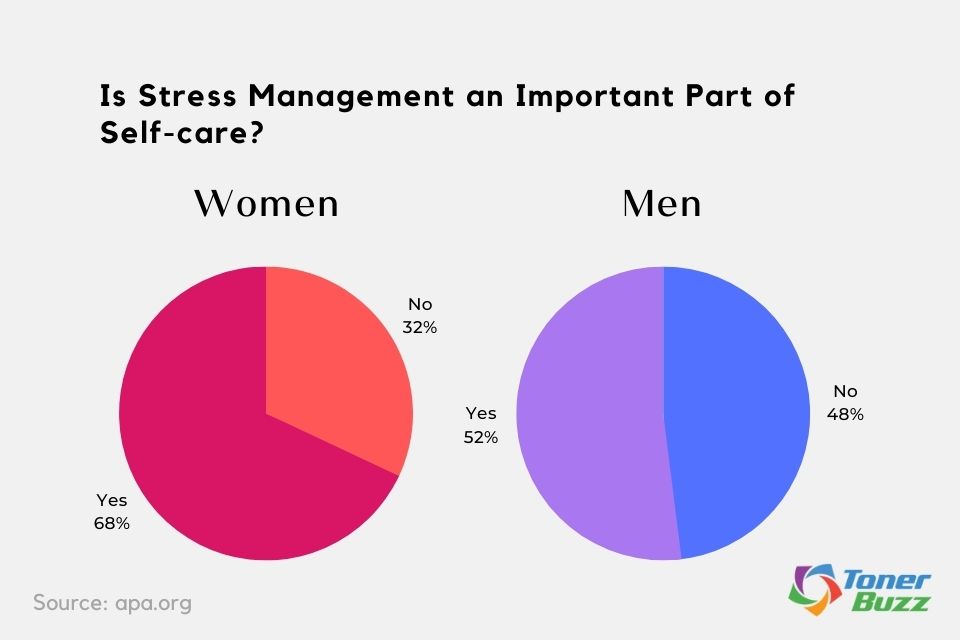
Men tend to burn stress-related tension through physical activities, like sports or exercise, while women opt for more soothing activities, like reading and holistic massage.
However, all methods of stress management and stress relief are gender-neutral and can be used by both men and women with equal effectiveness.
How Job Stress Age Us
The stress at workplace environments can not only make you sick -- it can make you old before your time.
A study conducted by the University of Michigan found stress shrinks telomeres, the microscopic organelles responsible for cell replication. Telomeres naturally shorten over time and are often associated with aging and age-related diseases.
The UM study revealed:
- People who work long hours at stressful jobs experience telomere shrinkage at six times the normal rate.
- Stressed-out workers are aging faster than their non-stressed counterparts.
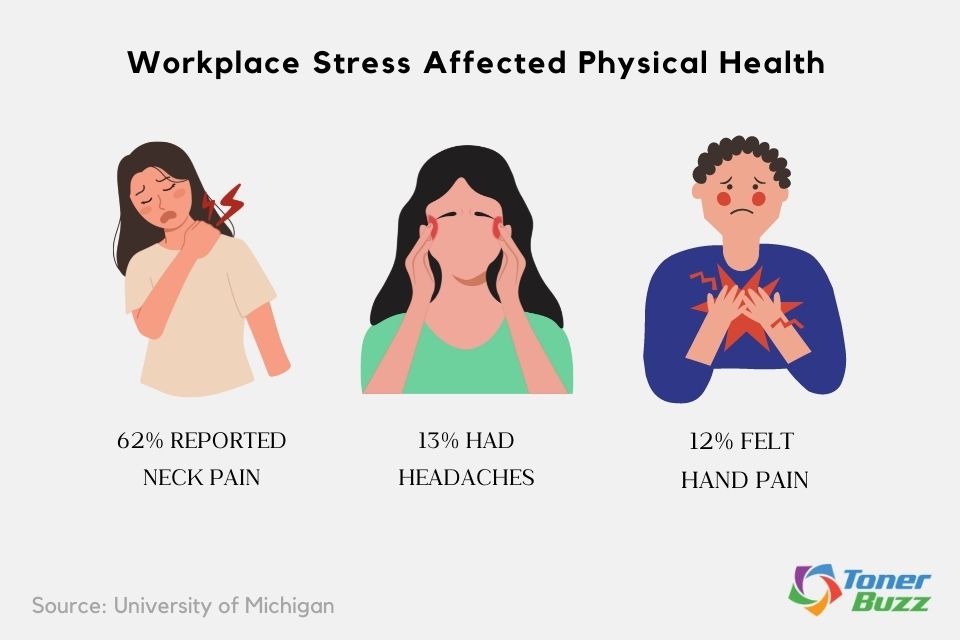
More than that, workplace stress affected physical health:
- 62% of respondents to a workplace stress survey report neck pain at the end of a workday.
- 13% say they have headaches at the end of a workday.
- 12% complain of hand pain at the end of a workday.
- More than a third of workers claim a stressful work environment affects their sleep.
- 50% of workers skip lunch due to an excessive workload.
- 27% of employees say work-related stress causes depression.
- Working more than 55 hours per week in a stressful job increases your likelihood of anxiety and depression.
- 76% of US workers said workplace stress makes their relationships and personal life more difficult.
- Workplace stress caused sleep deprivation in 66% of employees.
- 51% of employees feel “checked-out” at work.
How Stressed Employees Handle Stress
Stressed-out employees report they frequently skip lunch to combat stress stemming from a heavy workload. Workers suffer and quit their jobs when stress levels become overwhelming.
- 31% of employees deal with stress by consuming more caffeine.
- 25% of employees deal with stress by exercising more often.
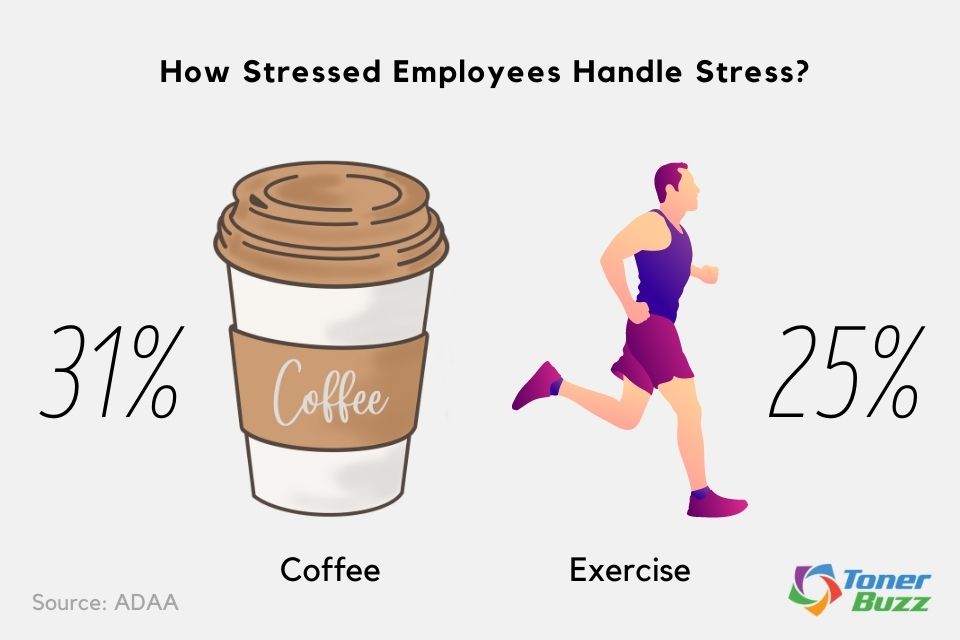
Which Age Group is the Most Stressed Out?
- The most stressed age group, according to the American Psychological Association (APA), is millennials aged 18-33 years old.
- Post-college students and first-time employees are among the most stressed-out populations.
- Employees aged 30-49 report the highest level of workplace stress.
- Work is among the top three sources of stress for Americans.

Clashes with bosses and co-workers are a major source of stress at work.
Global Work Stress Statistics
Job stress isn’t unique to America. It’s a global problem.
Workers around the globe feel the pressures of a high-stress work environment, especially in the wake of the COVID-19 pandemic.
According to The Workforce Institute at UKG, employee concerns about returning to work post-COVID vary from country to country.
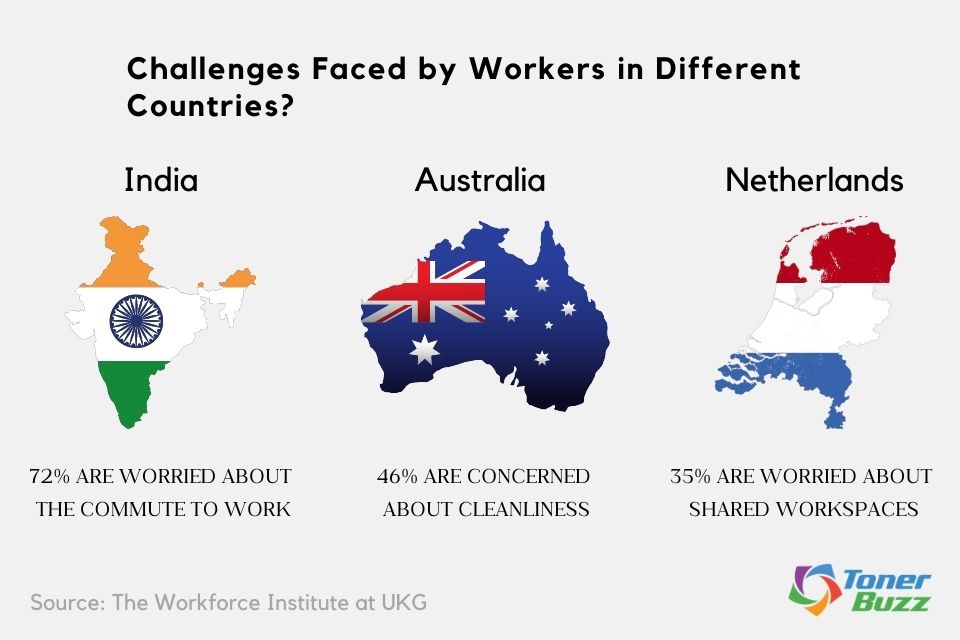
Let’s take a look at what worries workers around the world as they return to the workplace post-pandemic:
- 72% of employees in India are worried about the commute to work.
- 63% of Chinese workers have concerns about passing through high-traffic work areas.
- 60% of workers in Mexico have concerns about overall cleanliness.
- 50% of French workers are worried about the work commute.
- More than half of Canadian employees worry about cleanliness and sanitation.
- 47% of German workers have concerns about cleanliness.
- 46% of employees in Australia and New Zealand have concerns about cleanliness.
- 35% of employees in the Netherlands are worried about shared workspaces.

Unrealistic goals and expectations are another major cause of workplace stress.
Is Remote Work A Solution To Work Stress?
COVID-19 taught businesses owners a lot about how to manage remote teams.
When much of the workforce began working from home during the pandemic, it became harder to separate job responsibilities and family duties.
Many employees tasked with working from home for the first time found they liked it and saw flexibility in scheduling as a permanent part of their work lives going forward.
Business owners found they could reduce the effect of stress at work and increase overall productivity by switching to remote work teams.
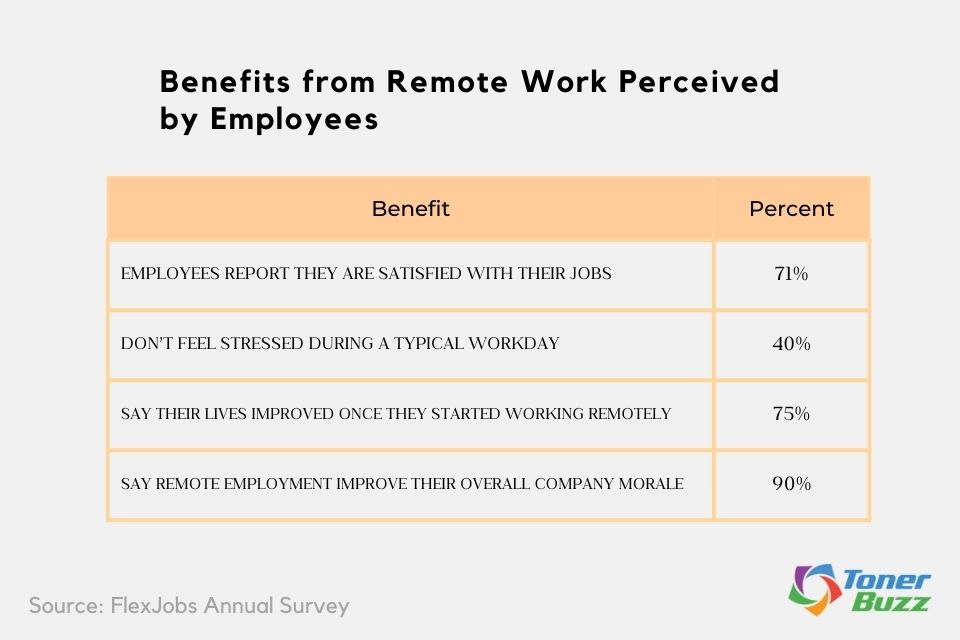
Happier, stress-free employees work harder and deliver better results!
- 84% of freelance employees are pleased with their work-life balance.
- 71% of remote employees report they are satisfied with their jobs, compared to 55% of office-based employees.
- 40% of remote employees say they don’t feel stressed during a typical workday.
- Remote employees work an average of 1.4 more days per month than office-based employees.
- 75% of stressed office workers say their lives improved once they started working remotely.
- 78% of stressed workers believe flexible schedules are a good way to retain employees.
- 82% of US companies are using flex-time to help improve the work-life balance of their staff.
- 83% of employees say the ability to work remotely part of the time is a deal-maker when accepting a new position.
- 90% say flex-time and remote employment improve their overall company morale.

Manage your time wisely and you’ll have less stress at work … and in life!
Check out our article on Work-Life Balance Statistics
Creating A Stress-Free Workplace
There are serious consequences when workers experience stress. Sickness absence costs a lot of money and funds to cover the loss of workplace productivity. That's not even factoring in the human cost to health and well-being.
Forbes suggests the following to create a stress-work workspace:
- Change your office layout, redecorate, and add plants!
- Keep your workspace organized and clean
- Make your workspace "yours" by adding your personal touch
- Interruptions happen — learn to either ignore them or deal with them in a stress-free way
- Adapt to changes
- Be a good communicator
- Incorporate relaxation exercises into your daily routine
In the wake of a global pandemic, we find ourselves in a general mental health crisis. Workers feel stress, which leads to depression, and depression leads to more stress. Stressed office workers feel employers should share the annual costs for a diagnosed mental health condition related to stress levels on the job.
No job is without inherent pressures. But most workplace stress isn’t linked to physical tasks as much as it is to other people. Bossy bosses. Unsympathetic coworkers. Careless colleagues. Many causes of stress in the workplace could be alleviated simply by good manners and basic etiquette.
Avoid office politics and be polite. No one is “out to get you.” Everyone at the workplace is on the same team, working toward the same goals.
Everybody works at their own pace.
Some fly from one task to another. Others work more slowly. Others contemplate each task and work more mindfully.
Neither method is wrong as long as the work gets done.
The key to reducing the cost of stress in the workplace is allowing employees to find the best work method for them, producing the most significant results with the least amount of stress.
Further reading:
➜ Workplace Whirlwind: 63+ Jaw-Dropping Employee Engagement Statistics
➜ Eye-Opening Work-Life Balance Statistics
- Anxiety and Depression of Association of America (ADAA)
- American Psychological Association (APA)
- American Psychiatric Association Foundation Center for Workplace Mental Health
- comparecamp.com/work-life-balance-statistics/
- teamstage.io/work-life-balance-stats/
- fingerprintforsuccess.com/blog/conflict-resolution-skills
- stress.org/42-worrying-workplace-stress-statistics
- ukg.com/about-us/newsroom/physical-safety-psychological-security-job-stability-employees-worldwide-share-top-covid-19-concerns
- adaa.org/workplace-stress-anxiety-disorders-survey
- kornferry.com/insights/this-week-in-leadership/workplace-stress-motivation
- apa.org/news/press/releases/stress/2014/stress-report.pdf
- stress.org/workplace-stress
- workplacementalhealth.org/Mental-Health-Topics/Workplace-Stress
- nytimes.com/2019/07/25/well/live/how-job-stress-can-age-us.html
- nsc.org/newsroom/new-mental-health-cost-calculator-demonstrates-why#:~:text=Employees%20experiencing%20mental%20distress%20use,Distress%20varies%20greatly%20across%20occupations.





